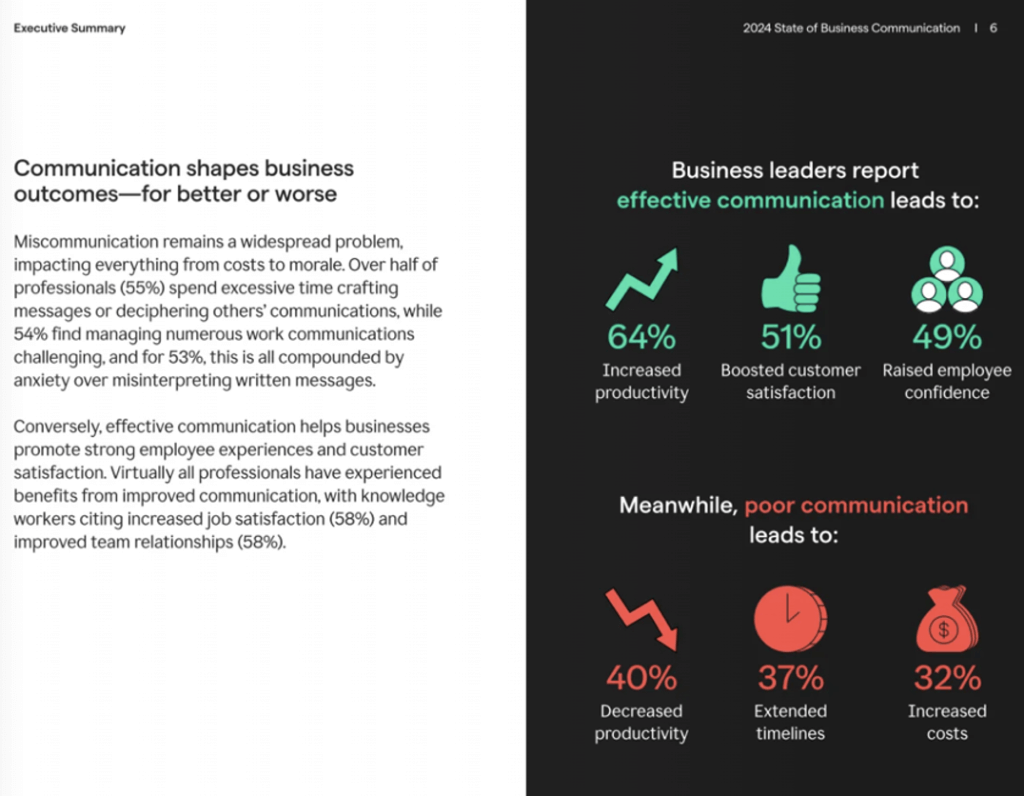Grammarly continues to innovate rapidly, with announcements today demonstrating the company’s focus on making it easier for enterprise customers to deploy Gen AI comms assistance across the organization. This is a timely move because as generative AI becomes more popular across the enterprise, concerns about quality control are rising—and rightfully so.
Deploying Gen AI Across the Enterprise Can Be Scary, Grammarly is Working to Change That
As enterprises worldwide are venturing into the realm of generative AI, it’s crucial to address concerns about security, data privacy, quality control, compliance, and flexibility. That’s where Grammarly comes in. Grammarly is no newcomer to the AI scene; its functionality has been powered by AI long before AI became the buzzword du jour. Grammarly’s secure, private, and responsible enterprise-grade AI solution is currently in use by one-third of the Fortune 500. This speaks to the confidence enterprises have in using Grammarly to harness better communication to drive business outcomes, helping teams be more efficient, communicate more effectively, and also protect the brand while complying with industry regulations.
Grammarly’s launch this week of a new set of enterprise features is all about integrating into corporate-wide business communications and facilitating the deployment of AI-powered communication assistance securely and seamlessly. Think of it as a worldwide communications layer for businesses that users don’t have to think about activating. It’s just there, working alongside them every step of the way, helping make their business communications more efficient, effective, compliant, and secure.
Grammarly’s New Enterprise Features
Grammarly’s new enterprise features announced today are centered around security, ease of deployment and use, compliance, and facilitating seamless adherence to brand standards. These new enterprise features include:
Custom Roles. Custom roles functionality allows the setting of admin roles based on the level of access needed.
Cost Control. Grammarly’s cost control/visibility features provide enterprises with a centralized, holistic view of Grammarly license usage across the organization as a whole, so there are no surprises. In the days of rapidly escalating costs associated with the adoption of generative AI, this might be one of my favorite features.
Security Controls. Grammarly’s Security Controls are driven by organizational policies and configured by groups. They configure domain and application blocklists, effectively balancing security and usability.
Session Timeout. Security is a foundational premise at Grammarly, and baked into everything the company does. Session Timeout functionality allows a control to be set for users to re-authenticate at whatever intervals determined by the security team.
Bring Your Own Key. Grammarly’s Bring Your Own Key functionality allows the use of personal encryption keys for use with application-level Grammarly data at rest, providing full control over key access, decryption, as well as the ability to view access logs when desired.
Figma Plug-In. The Figma Plug-In feature allows enterprise users to download the Grammarly plug-in from the Figma plug-in marketplace, which means that users can rely on Grammarly during the design process.
Note that all of the features listed here are available for Enterprise customers only, with the exception of the Figma Plug-In, which is available to all Grammarly users.
Business Communication is Where Workers Spend a Majority of their Time
Why do these enterprise-focused features from Grammarly matter? Enterprises are, without question, communication engines. Most of us — at the enterprise level and beyond — spend a significant part of our days communicating: writing emails, text messages proposals, sales follow-up, customer interactions — you name it, we’re writing it. In fact, in the 2024 State of Business Communication research conducted by Grammarly and The Harris Poll, survey data showed that a whopping 88% of the work week is spent communicating with others across multiple channels, with 84% of business leaders sharing they are communicating more, over more channels, than ever before. Here’s a look from the study at the average hours each week people spend communicating.

With the volume of business comms being so great, maintaining quality control, protecting the organization’s brand, and ensuring communication is happening in a compliant manner are key concerns. As shown in the 2024 State of Business Communication study, miscommunication is viewed as widely problematic, often leading to a lack of clarity, anxiety, a massive drain on time, lost productivity, and increased costs.

Better Communication Significantly Shapes Enterprise Business Outcomes
Better communication can shape enterprise business outcomes in ways that impact the bottom line in myriad ways. Consider but one example: have you ever received a poorly written email or proposal from a salesperson? Did it make you excited about potentially doing business with the sender? I will admit that I’m a tough audience, raised by a family of teachers, readers, and obsessive grammarians. But to me, business communications is a window into what working with an individual or the organization they represent will be like. While mistakes can and will happen, if business communications are poorly written beyond a simple typo here or there, I find myself wondering whether this lack of attention to detail is a precursor of what I can expect from a work product standpoint from that individual and their organization. In short, these are the people and the firms I generally don’t rush to do business with: I don’t feel that I can trust the quality of the outcome.
We are communicating more, in more places, and often at a more rapid pace than ever before. Data from the 2024 State of Business Communication study indicates we are spending about 19 hours on average a week on written communication tasks. Extrapolate that across an enterprise, where decisions are regularly based on written communication, and you can easily see the impact communication has on business outcomes.
Why Grammarly Enterprise?
As I said earlier, I don’t know if enterprise leaders and ITDMs who are thinking about generative AI are considering Grammarly, but they should be. Grammarly works across all apps and sites, seamlessly looking over a user’s shoulder as they write and serving up suggestions to make written communication more succinct, impactful, and accurate. There’s no cutting and pasting, no learning curve, no hassle.
When every organization on the planet is shifting budget dollars to fund generative AI initiatives consider this: organizations that deploy Grammarly save an average of $5,000 per employee per year. Moreover, Grammarly doesn’t ever sell customer data, provide it for advertising purposes, or allow third parties to use it to train their models.
Still not convinced? Maybe these enterprise customer results will get your attention.
Bottom line, I wasn’t a believer in the power of Grammarly — until I started using it. Now, I can’t imagine not having the assistance Grammarly provides across everything I write and create all day long.
Grammarly is built on 15 years of secure, private, responsible AI, and boasts enterprise-grade regulatory certifications, a longstanding commitment to customer privacy, and a partnership with Microsoft on the security front that provides enhanced security controls and flexibility. Beyond the obvious benefits, when Grammarly’s enterprise customers are willing to step up and share their results, it’s impossible not to be impressed with the outcomes they are experiencing. Better corporate comms have a definitive impact: on the bottom line, on culture and employee experiences, and on the ability to deliver the very best in customer experiences.
Image credit: Pexels, Andrea Piacquidao
See more of my coverage here:
Trustwise’s Optimize:ai Launches, All Eyes on Gen AI Safety and Efficiency
Grammarly’s Strategic Suggestions Launch Signals the Company is Far More Than an Editing Solution



